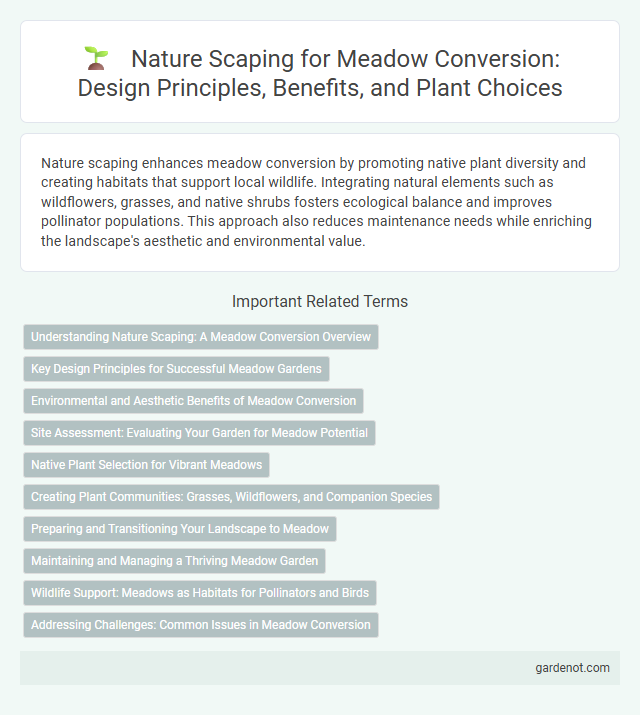Nature scaping enhances meadow conversion by promoting native plant diversity and creating habitats that support local wildlife. Integrating natural elements such as wildflowers, grasses, and native shrubs fosters ecological balance and improves pollinator populations. This approach also reduces maintenance needs while enriching the landscape's aesthetic and environmental value.
Understanding Nature Scaping: A Meadow Conversion Overview
Nature scaping through meadow conversion transforms traditional lawns into biodiverse habitats by planting native grasses and wildflowers that support pollinators and wildlife. This sustainable landscaping approach improves soil health, reduces water usage, and enhances ecosystem resilience. Emphasizing native plant species and minimal maintenance creates vibrant, ecologically valuable spaces that restore natural balance in urban and suburban environments.
Key Design Principles for Successful Meadow Gardens
Key design principles for successful meadow gardens include selecting native plant species that support local biodiversity and provide habitat for pollinators. Incorporating diverse plant heights and bloom times ensures continuous visual interest and ecological function throughout the growing season. Effective soil preparation and adaptive management techniques, such as controlled mowing and minimal nutrient input, promote sustainable meadow establishment and long-term health.
Environmental and Aesthetic Benefits of Meadow Conversion
Meadow conversion enhances biodiversity by providing vital habitats for pollinators, birds, and small mammals, promoting ecological balance and soil health. The natural plant diversity in meadows supports carbon sequestration and reduces erosion, contributing to climate change mitigation. Visually, meadows offer vibrant seasonal colors and textures, creating aesthetically pleasing landscapes that increase property value and encourage outdoor recreation.
Site Assessment: Evaluating Your Garden for Meadow Potential
Site assessment for meadow conversion involves analyzing soil type, drainage, sunlight exposure, and existing vegetation to determine the garden's suitability for native wildflowers and grasses. Understanding microclimates and identifying areas with minimal disturbance optimize plant establishment and biodiversity. Accurate site evaluation ensures the selection of appropriate seed mixes, promoting long-term meadow health and ecological balance.
Native Plant Selection for Vibrant Meadows
Native plant selection enhances meadow conversion by promoting biodiversity and supporting local ecosystems. Choosing species adapted to the regional climate ensures vibrant blooms and sustainable growth throughout the seasons. Incorporating a diverse mix of native grasses and wildflowers creates resilient habitats that attract pollinators and improve soil health.
Creating Plant Communities: Grasses, Wildflowers, and Companion Species
Creating plant communities in meadow conversion involves selecting a diverse mix of native grasses, wildflowers, and companion species that complement each other's growth habits and ecological functions. Incorporating deep-rooted prairie grasses like little bluestem enhances soil stability and water retention, while wildflowers such as coneflowers and black-eyed Susans attract pollinators essential for ecosystem health. Companion species like legumes improve soil nitrogen levels, promoting sustainable growth and fostering a resilient, self-sustaining meadow habitat.
Preparing and Transitioning Your Landscape to Meadow
Preparing and transitioning your landscape to a meadow involves removing existing turf and invasive plants to create a biodiverse habitat that supports native flora and fauna. Key steps include soil assessment, seed selection of native grasses and wildflowers, and implementing phased mowing or controlled burns to encourage healthy meadow growth. Proper timing during early spring or fall optimizes seed germination and long-term meadow establishment.
Maintaining and Managing a Thriving Meadow Garden
Maintaining and managing a thriving meadow garden involves regular monitoring of plant health, selective weeding, and seasonal mowing to promote biodiversity and prevent woody plant encroachment. Utilizing native wildflowers and grasses adapted to local soil and climate conditions enhances ecosystem resilience and supports pollinators such as bees and butterflies. Implementing rotational mowing schedules and minimal fertilizer use helps sustain soil quality and encourages a vibrant, balanced meadow ecosystem.
Wildlife Support: Meadows as Habitats for Pollinators and Birds
Meadow conversion enhances biodiversity by creating rich habitats that support a diverse range of pollinators such as bees, butterflies, and hoverflies. Native flowering plants provide essential nectar and pollen sources, fostering robust insect populations crucial for ecosystem health. These vibrant meadows also offer shelter and nesting grounds for various bird species, promoting avian diversity and sustaining local wildlife communities.
Addressing Challenges: Common Issues in Meadow Conversion
Soil quality remains a critical challenge in meadow conversion, often requiring amendment to support native wildflowers and grasses. Invasive species pose a persistent threat, necessitating ongoing management to ensure biodiversity and ecological balance. Effective water management strategies are essential to prevent both drought stress and waterlogging, which can hinder meadow establishment and growth.
Nature scaping Infographic

 gardenot.com
gardenot.com